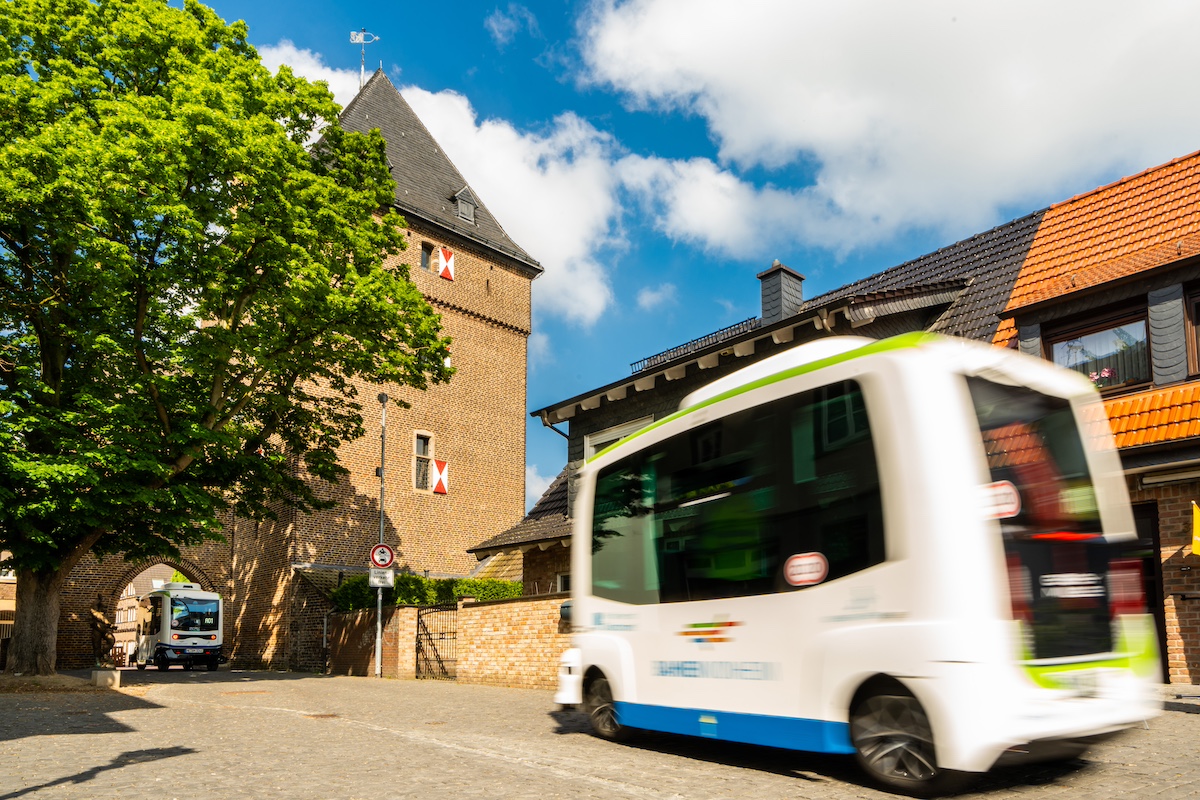Autonomous shuttles integration into Monheim’s public transport
Germany, like many countries worldwide, is actively working to expand local public transport as part of a broader mobility transition. This strategy aims to enhance eco-mobility and promote the use of sustainable transport. Driverless and electric shuttles have emerged as a key innovation in this effort, offering a flexible, efficient, and environmentally friendly alternative to conventional buses. These smaller, automated vehicles are designed to improve public transport reliability and cater to individual passenger needs more effectively, potentially reducing the reliance on private cars.
In February 2020, the town of Monheim am Rhein in North Rhine-Westphalia launched an autonomous shuttle service that stands out due to its full integration into the local bus network. This permanent service, comprising five EasyMile autonomous shuttles, operates between the bus station and the old town, covering a 2-kilometer route with six stops. These shuttles aim to increase public transport connectivity and accessibility, especially in areas previously inaccessible to conventional buses due to narrow streets.
These shuttles can transport up to 11 passengers, including six seated. The service not only enhances public transport options but also aims to improve road safety by reducing human error and to familiarize residents with automated technology, thereby increasing acceptance and fostering digitalization. Each journey is accompanied by an operator responsible for technical monitoring and passenger assistance.
Monheim am Rhein is pioneering the integration of a driverless shuttle fleet into regular public transport service. This initiative, supported by the Karlsruhe Institute of Technology (KIT), involves extensive research to understand public acceptance and the impact on mobility behavior. Since late 2021, KIT has conducted empirical studies, including passenger surveys, interviews with minibus attendants, and household surveys, to gather comprehensive insights.
Key findings on user acceptance and mobility impact
The research revealed that typical users of the automated minibus line are predominantly female, older, or mobility-impaired individuals, often retirees. For these groups, the minibus serves as a crucial mobility enabler. Unlike many on-demand services, the regular schedule of Monheim's shuttles ensures low access barriers, making it more inclusive. The study revealed the following key findings:
- User profile and accessibility: The automated minibus service is particularly beneficial for older adults and those with mobility impairments, providing them with a reliable and accessible transportation option. The ease of access due to the fixed schedule has made public transport more inclusive.
- Integration and mobility behavior: The minibus line's integration into Monheim's existing public transport network has increased overall accessibility and encouraged public transport use. While initial curiosity has turned into regular use, primarily for leisure and home journeys, a potential increase in travel speed could broaden its appeal for work and business trips.
- Satisfaction and acceptance: High satisfaction levels among users and a significant willingness to use the service among non-users were noted. Over time, passengers have grown accustomed to the minibus characteristics, rating them more positively.
- Safety perception: Passengers reported a strong sense of safety, largely due to the presence of attendants who also provide valuable customer service. However, the willingness to use the service without attendants suggests growing trust in autonomous technology. The attendants play a critical role in passenger comfort and loyalty, indicating a need to address the service role they fulfill if attendants are phased out in the future.
- Non-User feedback: Non-users primarily criticize the current driving style and speed. Despite this, many express a willingness to try the service, especially if travel speed increases and the service can act as a feeder to S-Bahn stops.
Future enhancements for an ideal mobility service
Research on the driverless shuttle service in Monheim am Rhein suggests improvements to make it more appealing. One key area is increasing speed, especially for non-users who find it too slow for commuting or work trips. Matching the speed of regular buses could make the minibus a more competitive option.
Another opportunity lies in connecting the minibusses to the regional S-Bahn train system. This would allow passengers to seamlessly transfer between the minibus and the train network for more efficient travel. Additionally, technical improvements are needed to smoothen driving behavior and interaction with other vehicles, leading to better service reliability and user satisfaction.
The autonomous shuttle service in Monheim am Rhein has shown promise in enhancing public transport for specific user groups and integrating into the city's mobility framework. The high awareness and positive response underscore the success of making digitalization and autonomous driving tangible for residents.

